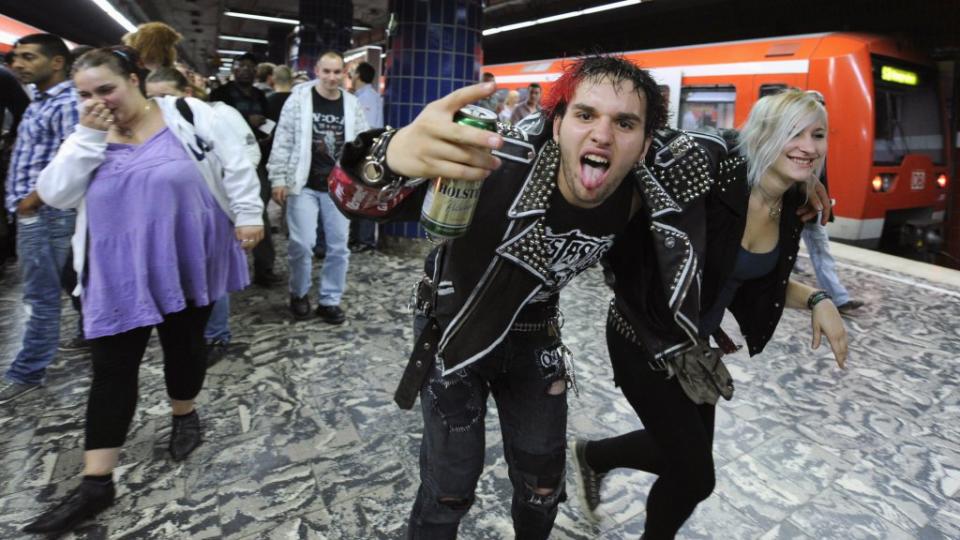The pros and cons of running a subway all night long

The London Underground—or at least part of it—will open all night tonight (Aug. 19) for the first time, putting it into an elite group of cities with subway trains running through the night.
Just two cities—Copenhagen and New York—run a subway 24/7. London’s Tube won’t make that podium—the Night Tube will only run on Fridays and Saturdays, starting with just two lines and another three to follow later in the autumn. (The other cities that have weekend night services are Berlin, Vienna, and Stockholm.)
Yet those two nights will cost the British capital £24.6 million ($33 million) a year to run, with Transport for London (TFL) expecting it to take three years to break even. The launch has already been delayed by almost a year due to aggravated rail unions. Throw in the image of late-night drunken crowds, and it’s worth asking: Is an all-night subway really worth it?
Night thrills
Any city worth its salt has a vibrant nightlife to match.
The night economy of London was worth £26 billion a year in 2014 and could grow to around £30 billion a year by 2030, according to an analysis by the Center for Economics and Business Research (pdf) commissioned by business association London First and EY.
But customer footfall is only as good as the transport system getting them to your door, and indeed back home.
Over half a million people already use the London Underground after 10pm on a Friday or Saturday, a rise of 70% over the last 15 years, say TFL. London has a system of night buses—themselves seeing a 170% rise in use (pdf) over the same period—but waits and journeys can be long and inevitably packed with the inebriated, many simultaneously turfed out of pubs, bars, and clubs at the same closing times.
A late-running or 24-hour subway resolves some of these issues. Bars, pubs, clubs restaurants, and shops could potentially lengthen their opening hours—or at least stagger closing times.
TFL say that the Night Tube will cut journeys by 20 minutes to an hour. It is fitting shock-absorbers to tracks to try to reduce the rattling of trains for residents particularly close to tracks when the Tube is above ground.

Around 723,000 London jobs—one in eight—involve night work. According to the CEBR report, the Night Tube alone could generate more than 2,000 new jobs, 500 of which would be directly employed by the metro service.
The report’s authors say that the potential benefits could go even further, boosting the economy through extended and flexible business hours. “In Singapore there are banks that trade on the same hours in London,” John Dickie of business association London First, who helped commission the report, told City AM. “Maybe we could have a financial services sector that works longer and different shifts.”
Night chills
But though new jobs are created, many will be poorly paid, transitory, and come with the risk of exploitative working conditions, Plymouth University’s Oliver Smith told the Guardian.
The stigma around “nightlife” also remains. While flexible working and all-night partying sound awesome, late night activity could also come with a rise in noise, litter, and crime. There are concerns around clean-up operation that city councils already have to grin and bear on weekends. TFL’s own risk assessment has warned of a rise in sexual offenses and rowdy behaviour in trains and stations once the Night Tube opens.
London police say they expect no overall change in crime rates, with most of the crime being the same that would have occurred on night buses just displaced onto trains. That said, London mayor Sadiq Khan is putting an extra 100 police officers on the streets to “set behavioral standards” at a cost of £3 million.
And just because the option is there doesn’t mean businesses or customers will take advantage.
The UK relaxed its alcohol licensing laws in 2005, potentially paving the way for 24-hour pubs and bars. But in practice, few felt it economical to do so. In Copenhagen (paywall), which does have a 24-hour subway, there are few restaurants open past 11pm.
The bigger question is whether the subway network itself will cope. In Copenhagen, trains can run in either direction on each track, allowing for maintenance. In New York, the main lines run on four tracks—two for express, two for local services—allowing services to run while maintenance takes place.
TFL says the weekend running won’t affect maintenance services, but as any long-suffering London commuter will tell you, British transport suffers from signal failures, train breakdowns, and delays caused by the “wrong kind of snow” at the best of times. (New York has a pretty disgusting, rodent-filled subway infrastructure, too, so it may not be the best example to follow when it comes to subway maintenance.)
And then there are all those people. Around 200,000 passengers are expected on the Night Tube every weekend. But Berlin, which began its weekend-running night subway in 1990, sees 800,000 passengers on its night network with a population less than half the size of London.
Finally, it is worth bearing that most cities in the world do not have all-night subways at all. Tokyo—a sprawling metropolis of 13 million people—doesn’t even have a night bus. There’s probably a good reason for that.


Sign up for the Quartz Daily Brief, our free daily newsletter with the world’s most important and interesting news.
More stories from Quartz:
